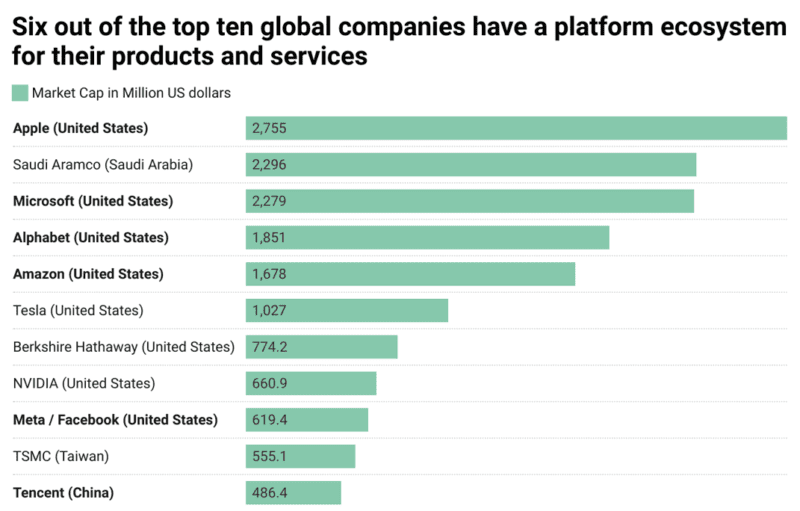Rethinking Copyright in the Age of Generative AI
Striking a balance between incentives and innovation
Solving age-old issues with new age solutions

Four of the top five companies in the world today share one thing in common. The one, recurring commonality amongst these global leaders— the platform approach.

Imagine a farmer accessing services related to crop, soil, middlemen, and markets all on one interface. Or directly purchasing a product from a small business owner, instead of purchasing it through a middleman. Or a young mother possessing the tools for a safer, well-informed childbirth. With the platform approach, citizens of the world now have the option to approach retail and impact interactions across sectors, across the globe, in a completely different light, entirely redefining producer-consumer exchanges.
Platform thinking entails systemic, foundational thinking to understand the problem we are trying to solve from the ground up.
Platform thinking entails systemic, foundational thinking to understand the problem we are trying to solve from the ground up. A platform is a singular unit that allows for exchange between two or more users in an open manner, allowing for the needs of all stakeholders to be fulfilled. It lets users create value for themselves and each other in a mutually beneficial model of functioning. The value exchange between the two can be in any form – e.g., products, services, knowledge, and information. A digital platform is an online interface that allows for this exchange to take place. The value addition for stakeholders on the platform is often proportional to the number of users – greater the number of users of the platform, greater the value imparted for all the stakeholders involved. Amazon, Uber, Venmo, Twitter, Instagram, Microsoft, Apple, Wikipedia, Google Play Store, YouTube – many of the world’s most successful models today are based upon the platform approach, as it allows for a model that will constantly evolve as per the needs of both parties involved. The platform plays an enabler role, catalyzing the interaction between parties. Ultimately, the platform could be defined as a ‘decentralized network of interconnected ecosystem actors orchestrating the flow of value’.

The platform model is an intervention model that allows for numerous participants to interact, exchange, and create value. The self-sufficiency of the platform relies upon high rates of usage across stakeholders; it may be considered successful if there are adequate producers and consumers. Today, the platform is the most efficient model to address pressing issues in the private and public sphere. Traditional businesses are still working in a system where they regard themselves as the sole source of value creation, however, platform companies regard value-creating users as the most important variable of their business model; meaning the most important resources lie outside of the company’s structure itself.
It is important to understand that while platforms are easier to spot in the realm of technology, they are not limited to technology
It is important to understand, however, that while platforms are easier to spot in the realm of technology, they are not limited to technology. Irrespective of the actual exchange being physical or digital, the unit that powers the matchmaking of producers with consumers (on the platform) is the information unit. Platforms, by nature, attempt to solve systemic issues by analyzing interdependencies of actors and influence in a system. By aligning the relevant actors, the platform approach, and platform thinking by extension, builds the necessary infrastructure required to facilitate the interaction for problem solving.
Open Digital Ecosystems (ODEs) are “open and secure digital platforms that enable a community of actors, private and public, to unlock transformative solutions for society, based on a robust governance framework”. ODEs consist of digital platforms, a community of actors and a governance to regulate the same. Digital public goods (DPI) are open-source software, open data, open AI models, open standards, and open content that adhere to privacy and other applicable laws and best practices. They are designed to be secure, privacy-enabled, and help attain the Sustainable Development Goals.

The world, which was already on a digital transformation path, accelerated its growth owing to the unprecedented COVID-19 pandemic. Digital public goods can be created across all thematic areas, but health emerged as the pressing need, especially during and after the pandemic, leading to the relevance and importance of platforms like Rapid Pro, mHero and Community Health Toolkit enabling an easier emergency medical experience. It is estimated that at least 70% of new value created in the economy over the next decade will be based on digitally enabled platform business models.
Owing to a focus on linear thinking in history, there has been a lack of focused platform thinking, making simple tasks arduous. Platforms hold the potential to solve for diverse, sector-wide challenges across economic, societal, and governmental aspects. The speed and scale of impact is accelerated in the platform approach owing to simplification of actions and the common channel for communication between various stakeholders. This decentralized, data-led approach has picked up globally, with a marked acceptance and shift toward the platform approach from the India Stack and UPI in India, Estonia’s digital infrastructure (such as X-tee), and the Singapore Government Design System, to name just a few.

The platform approach aggregates all relevant ecosystem actors in a common network to work toward impact. Value chains are integrated and simplified in a platform approach, allowing for a business opportunity for all stakeholders. Organizations like the Digital Public Goods Alliance (DPGA) completely rely on this foundational principle of multi-stakeholder engagement by identifying avenues for support from private sector technology experts, think tanks, governments, philanthropic donors, international implementing organizations, and even the UN. Resource mobilization for creation of safe, inclusive digital public infrastructures for social impact is a need that organizations like Co-Develop are trying to solve. Considering that the basic tenet of platform thinking is inclusive of the SDGs’ vision and mission, there is a unique role and value addition for impact entrepreneurs in the space.
Considering that the basic tenet of platform thinking is inclusive of the SDGs’ vision and mission, there is a unique role and value addition for impact entrepreneurs in the space.
In a survey conducted in August 2021, 16% of Americans reported to have earned money through an online gig platform; with a majority of these employees being from minority (primarily Hispanic) communities availing a source of income through these platform-enabled jobs. This number of gig economy workers leveraging digital platforms is only expected to grow over the years. Similarly in India, it is estimated that, by 2030, 10 high potential National Open Digital Ecosystems (NODE) across sectors can collectively create new value of USD 500+ billion – equivalent to 5.5% of India’s GDP, and in addition, generate USD 200+ billion in savings to the country. Platforms have greatly impacted countries and their economies in the past through job creation and are projected to continue doing so in a big way.
 While viewing and understanding platform infrastructure, it is important to note that platforms in isolation are not as valuable as they are when utilized for solution products. For example, in India the digital payments and ecosystem experienced a sharp boost after the formalization of Aadhaar (a national, digital identity platform infrastructure) and United Payments Interface (UPI) (a banking service to enable immediate payments and remittances) bringing is a host of national and international companies and formalizing the financial activity of over 330 million people in the country. Both platforms were created by the public (government) sector and then leveraged by private sector players, ranging from large multinationals to entrepreneurial startups, in innovative ways. However, it is important to note that these customer-facing solution products were built upon existing infrastructure; that is, without UPI these products would not exist. It allowed for competition and innovation, with PhonePe, PayTM, Google Pay, Amazon Pay and others contending to be the consumer’s favorite payments app. These solution applications are capable of performing at extraordinary levels. Just in the month of February 2022, there are over 2,120 million transactions on PhonePe, 1,524 million transactions on GooglePay and 706 million transactions on Paytm, the three apps transacting a total combined value of USD 102+ million.
While viewing and understanding platform infrastructure, it is important to note that platforms in isolation are not as valuable as they are when utilized for solution products. For example, in India the digital payments and ecosystem experienced a sharp boost after the formalization of Aadhaar (a national, digital identity platform infrastructure) and United Payments Interface (UPI) (a banking service to enable immediate payments and remittances) bringing is a host of national and international companies and formalizing the financial activity of over 330 million people in the country. Both platforms were created by the public (government) sector and then leveraged by private sector players, ranging from large multinationals to entrepreneurial startups, in innovative ways. However, it is important to note that these customer-facing solution products were built upon existing infrastructure; that is, without UPI these products would not exist. It allowed for competition and innovation, with PhonePe, PayTM, Google Pay, Amazon Pay and others contending to be the consumer’s favorite payments app. These solution applications are capable of performing at extraordinary levels. Just in the month of February 2022, there are over 2,120 million transactions on PhonePe, 1,524 million transactions on GooglePay and 706 million transactions on Paytm, the three apps transacting a total combined value of USD 102+ million.
The biggest hurdle with digital platforms is the issue of the digital divide
However, the biggest hurdle with digital platforms is the issue of the digital divide. With access to the internet, smartphones and even basic literacy capabilities being so varied across the world’s population, the basic requirements to enable digital access are often lacking, especially in developing countries where social impact platforms are most required. There is also a prevailing gender gap when it comes to access to digital capabilities, with women having lower access than men. Data privacy and security is a grave concern for populations that do opt for platform access.
The platform approach to business has been proven successful, and the early signs of this thinking in the social sector are also proving to be fruitful. However, to ensure that there is a global shift toward platform thinking, there are numerous fundamental capabilities that require building. Digital literacy and accessibility are elementary needs that require fulfillment through funding. Philanthropy and impact investors can consider providing risk capita or patient capital to enable innovation in the space.

In a world with diverse socio-economic issues, a platform approach is a credible method to approach impact and solve for social problems at scale. While the route of adopting platform thinking is not as easy and requires a fundamentally different approach to impact and investments, it is the way forward.
Considering the rate at which the world is nearing a completely digital future, there is an overwhelming need to approach social problems with a newfound perspective. It is essential to reflect on the influence platforms have had in our lives over the past decades and the potential that it holds in the coming decades. The time to adopt a platform thinking mindset is now.
Related Content
Comments
Deep Dives
RECENT
Editor's Picks
Webinars

Featuring
Lizz Welch & Jennifer Roglà
iDE
May 16 - 12:00 PM EST

Impact Encounters
May 22 - 6:30 PM EST
News & Events
Subscribe to our newsletter to receive updates about new Magazine content and upcoming webinars, deep dives, and events.
Become a Premium Member to access the full library of webinars and deep dives, exclusive membership portal, member directory, message board, and curated live chats.
0 Comments